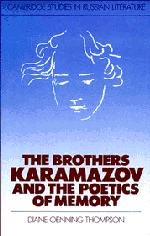Book contents
- Frontmatter
- Contents
- Preface
- Note on the text
- 1 Memory and poetics
- 2 The fictional narrator
- 3 Memory and the system of ascending plots
- 4 The memories of the characters: forms of affirmative memory
- 5 The memories of the characters: forms of negative memory
- 6 Forgetting
- 7 Foretelling
- 8 The Christocentric poetic memory system
- 9 Afterword
- Notes
- Bibliography
- Index
- Titles in the series
2 - The fictional narrator
Published online by Cambridge University Press: 05 November 2011
- Frontmatter
- Contents
- Preface
- Note on the text
- 1 Memory and poetics
- 2 The fictional narrator
- 3 Memory and the system of ascending plots
- 4 The memories of the characters: forms of affirmative memory
- 5 The memories of the characters: forms of negative memory
- 6 Forgetting
- 7 Foretelling
- 8 The Christocentric poetic memory system
- 9 Afterword
- Notes
- Bibliography
- Index
- Titles in the series
Summary
‘It's a poor sort of memory that only works backwards’, the Queen remarked.
Lewis Carroll, Through the Looking GlassIn every work of narrative fiction someone is conducting the narration, someone is playing the role of mediator in reporting the fictional events. Every narrator is a mediator who stands in varying degrees of proximity between the author, the story and the reader. For the very act of imaginative writing puts a distance between a living author and his fictitious creations. In Stanzel's words, ‘mediacy is the generic characteristic which distinguishes narration from other forms of literary art’. The agent of mediation, whether a narrator or a reflecting consciousness, is just as much a creation of the author's imagination as are the characters and their world. In fact Dostoevsky reveals his mastery of literary art very much in the way he renders mediacy in his fiction. This distance induced by mediacy is where our topic of memory comes to the fore. In The Brothers Karamazov there are many characters who relate their experiences and represent the speech of others. All the novel's strands of direct and indirect narration make for manifold points of view creating an intricate ‘polyphony’ of individuated consciousnesses. Still there is one fixed launching point for our discussion and that is the fictional narrator to whom Dostoevsky encharged the telling of the novel as a whole.
- Type
- Chapter
- Information
- The Brothers Karamazov and the Poetics of Memory , pp. 26 - 51Publisher: Cambridge University PressPrint publication year: 1991



